Twelve photos of nine species.
Three days ago I spent a wonderful early spring morning at Bear River MBR. I took a lot of photos that were interesting but might not deserve standalone status on Feathered Photography so today it’s my intention to present some of them en masse.
Sorry, with this many photos I don’t have time to include image techs.
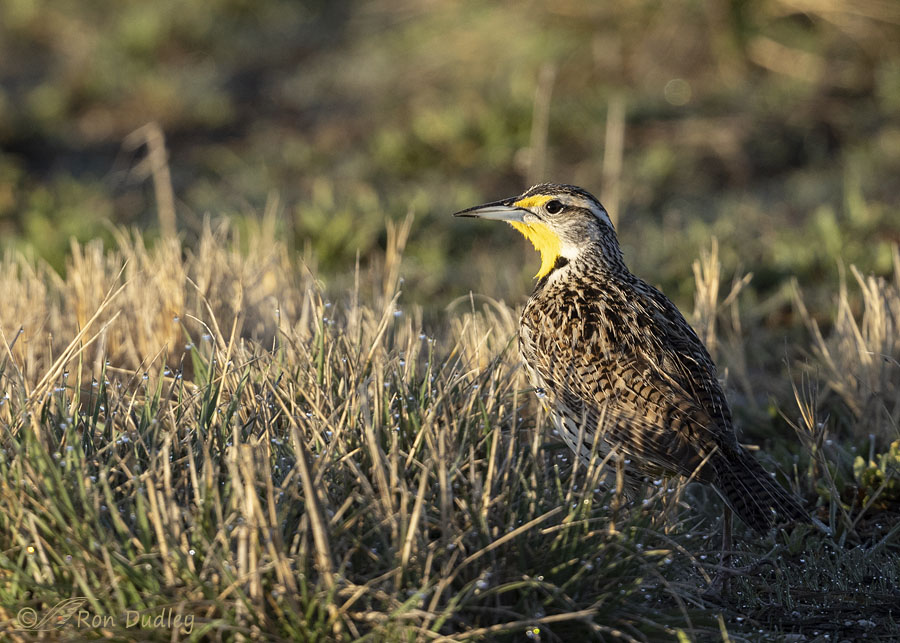
A Western Meadowlark foraging for food in the grasses at the refuge entrance. This photo was taken very soon after sunrise and the bright yellows of the bird were facing directly toward the sun so the exposure was a difficult one.
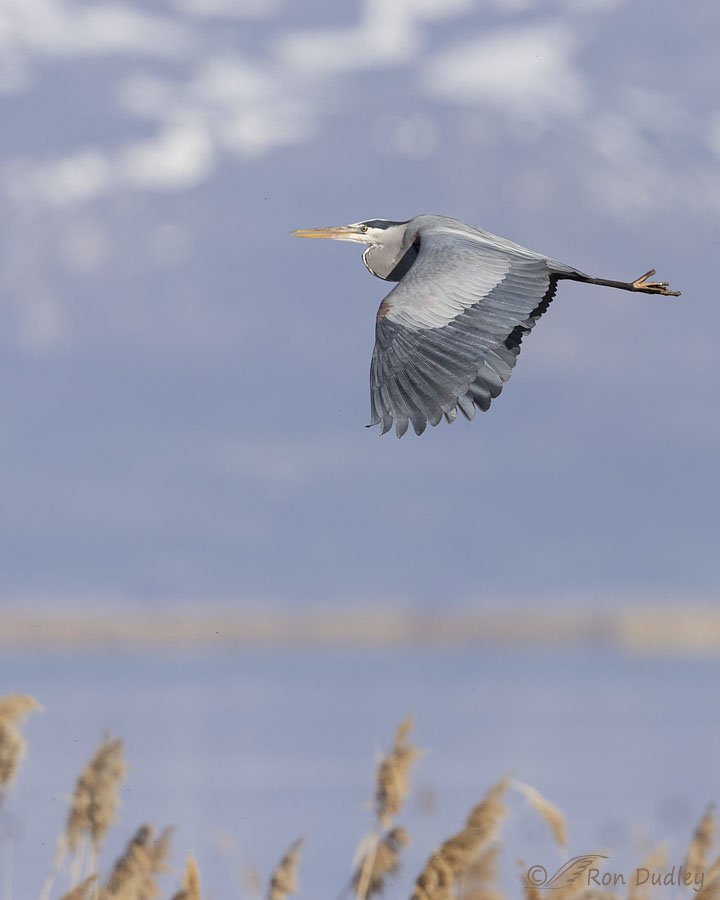
A Great Blue Heron flying over one of the ponds, with snowy mountains in the background.
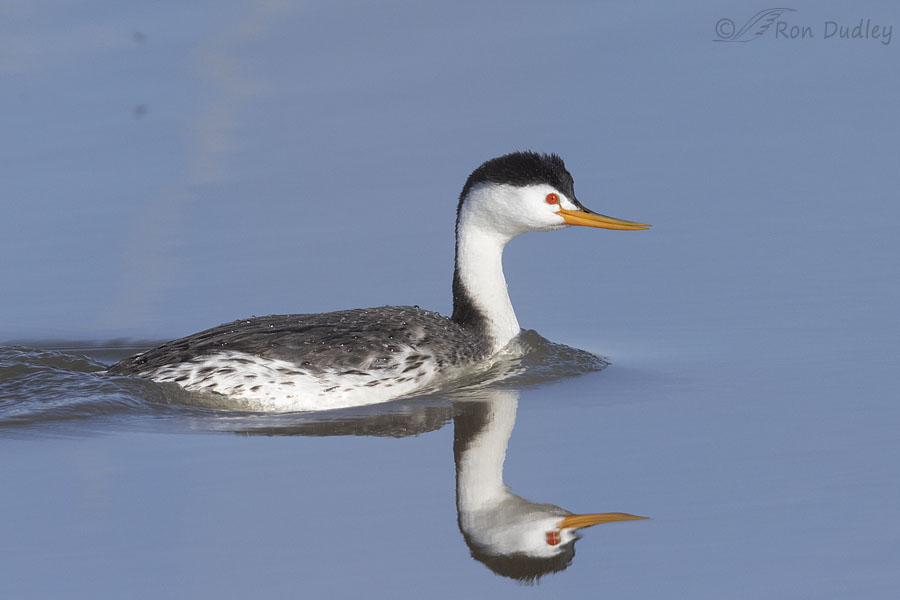
A very handsome Clark’s Grebe that played cat and mouse with me for a long time. The catch light in ‘his’ eye in his reflection looks a little like a plus (+) sign, giving him a starry-eyed look.
Lots of folks can’t tell the difference between Clark’s Grebes and Western Grebes so here’s a tip. The eyes of Clark’s Grebes are surrounded by white, while the eyes of Western Grebes are…
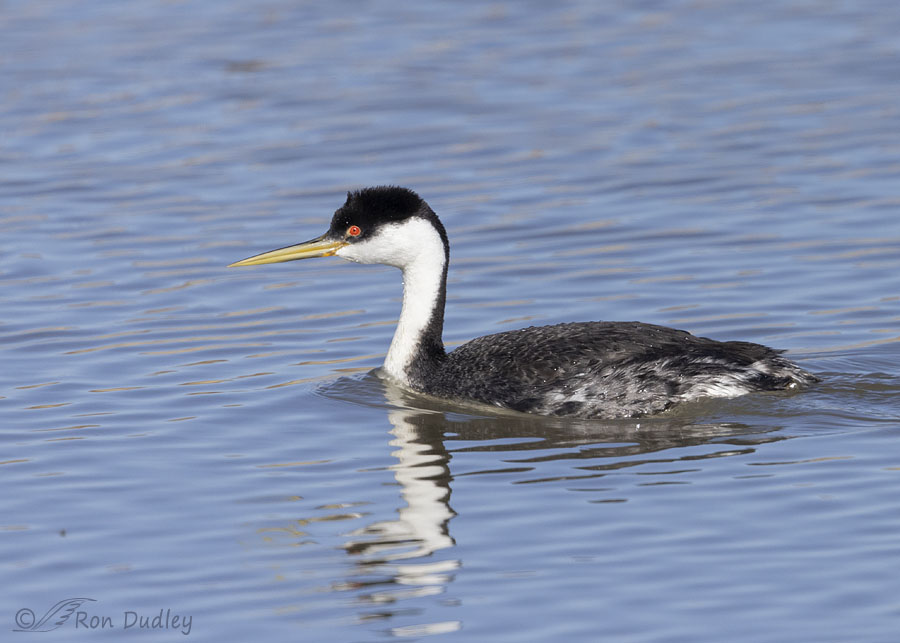
surrounded by black. There are other more subtle differences but that’s my go-to field mark.
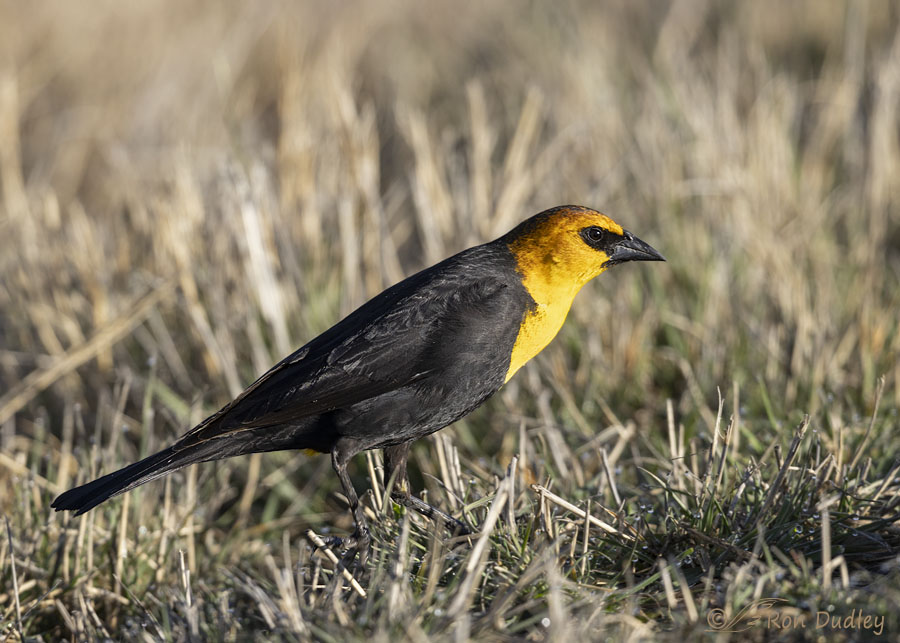
A Yellow-headed Blackbird searching for midges and other insects in the grass alongside the road. I was absolutely delighted to see masses of midges in flight along the south side of the auto tour route. Because of our severe drought, last year midges were pretty much a no-show and many birds paid the price for their absence because so many species depend on midges for food.
But on this morning, even this early in the year (and in the morning) when it hadn’t warmed up much, midges were plentiful enough in flight for me to see the beginnings of their famous midge tornadoes (midge-nados). That bodes well for birds.
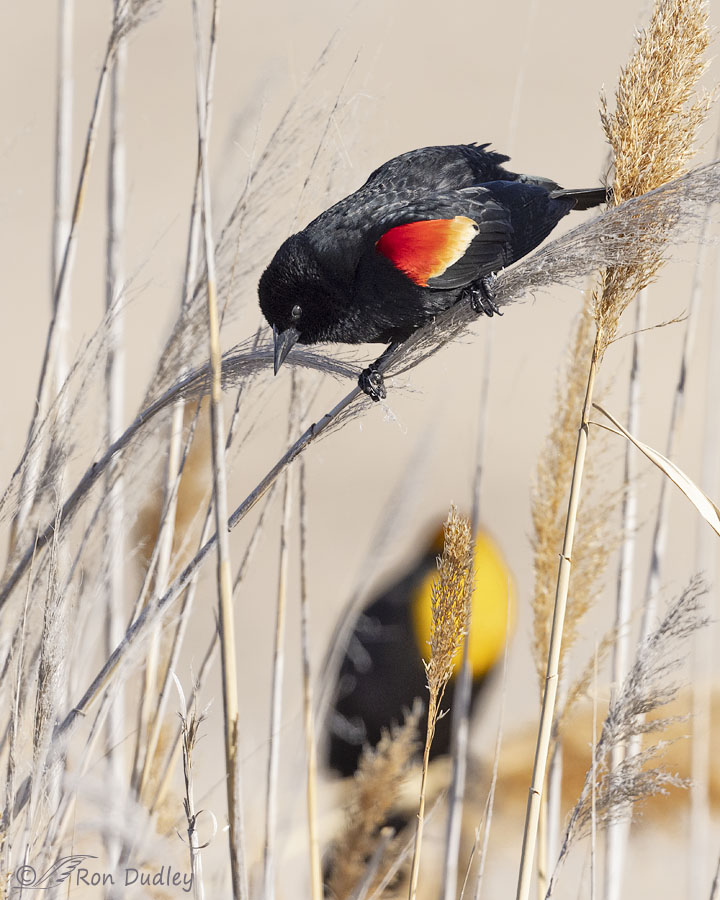
This Red-winged Blackbird had been displaying when the Yellow-headed Blackbird landed on a phrag stem below and behind him. The red-wing immediately stopped displaying, apparently because he was annoyed by the presence of the yellow-headed who was also displaying and stealing his thunder.
The red-wing was annoyed enough that he took off. But the yellow-headed continued to display so I wondered if I could pull my pickup forward and get some unobstructed photos of him and still have a good light angle on the bird.
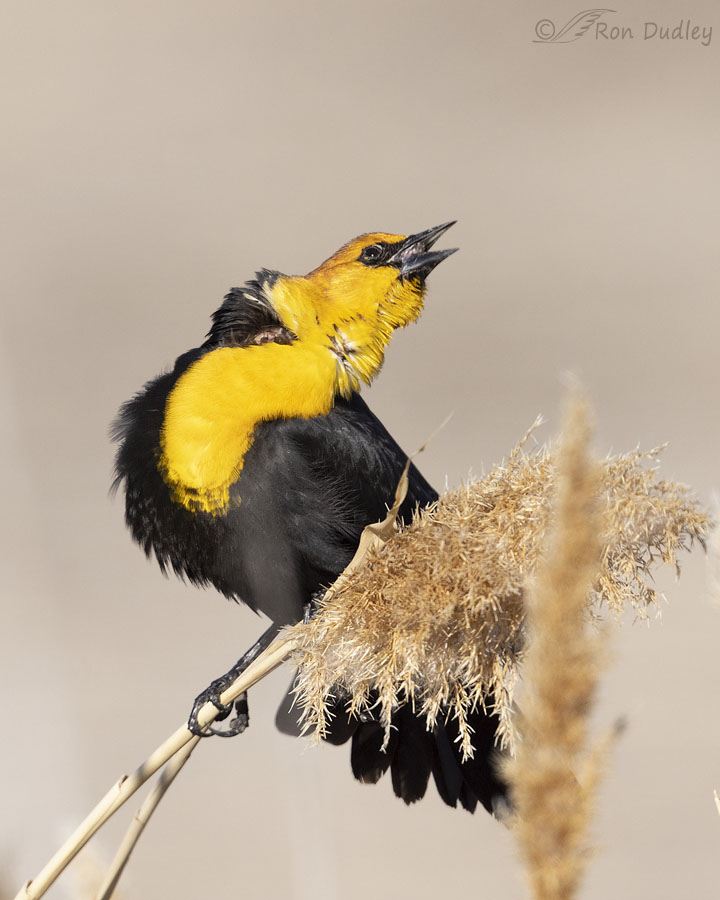
To my surprise I succeeded reasonably well.
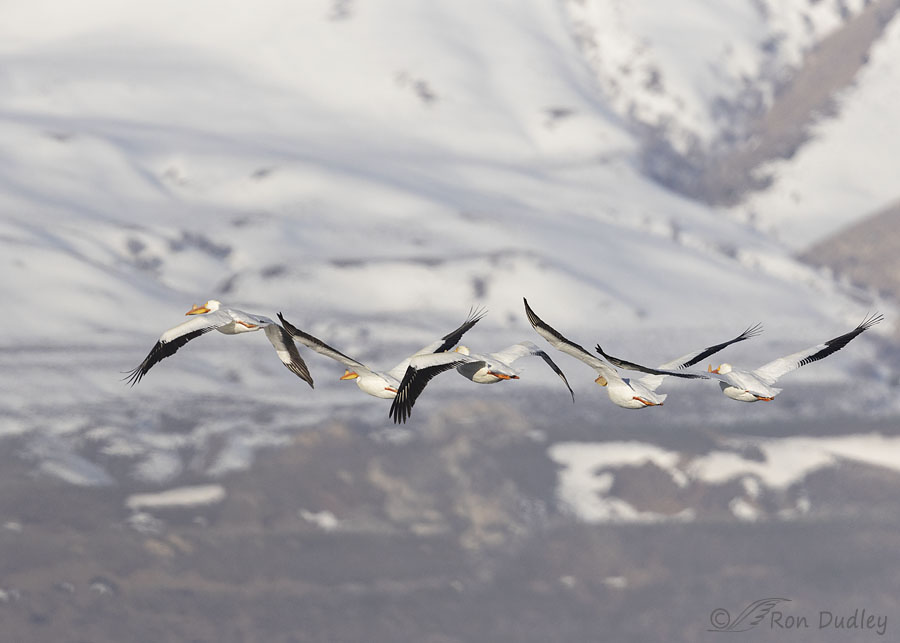
A butt shot of American White Pelicans in flight with the snow-covered Promontory mountains in the background. I kept hoping the pelicans would turn to the south (our left) so I’d have a broadside view of them but that didn’t happen. I’m including the photo in part because it should give readers a sense of place. Those mountains are a pretty spectacular backdrop at the refuge, especially this time of year.
To partially compensate for the long-distance butt shot…
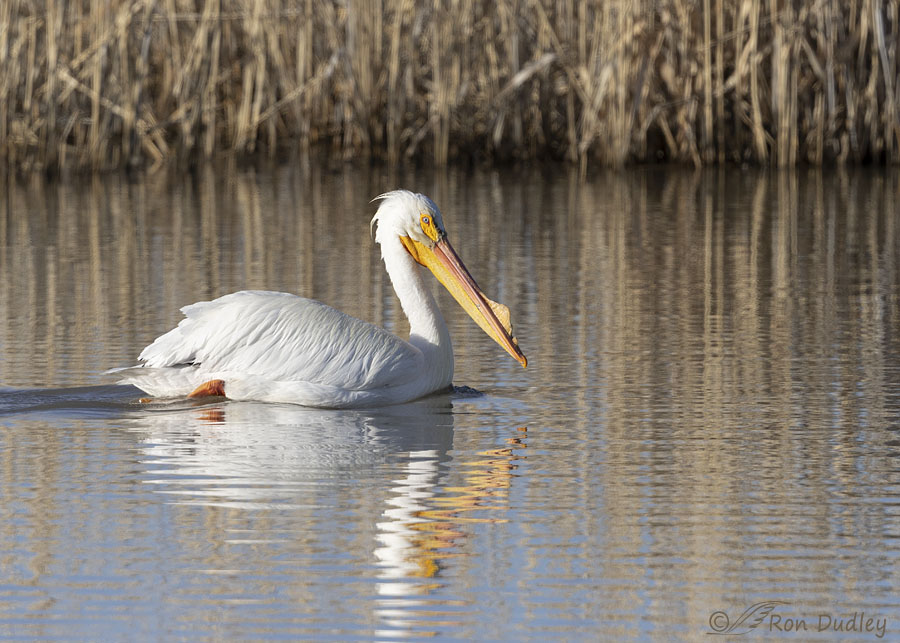
here’s a much closer side view of a pelican on one of the ponds.
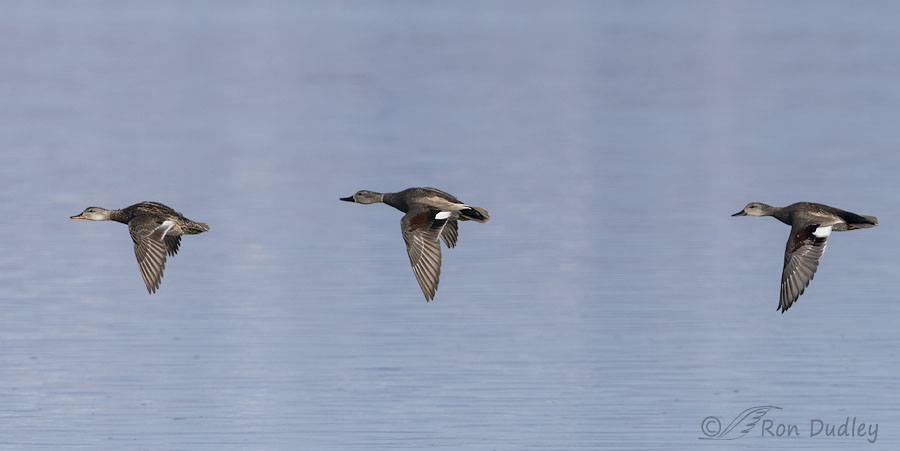
A trio of Gadwalls zooming across one of the large ponds. At first I was a little confused by the ID of these ducks because the drake in the middle has a white ring around his neck and there’s another white ring at the base of his bill. Those rings normally wouldn’t be there so maybe they’re a result of molting? Or a little fooling around by one of his parents, resulting in hybrid characteristics? I dunno.
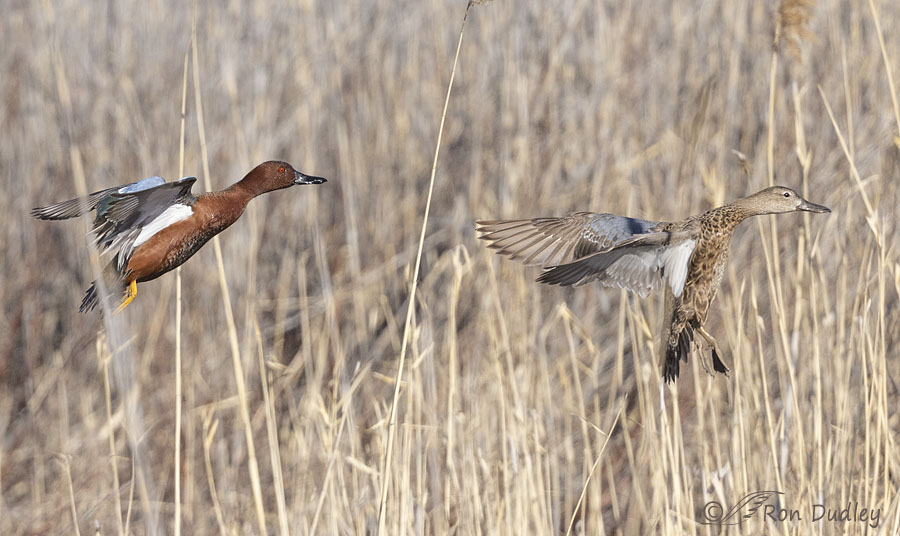
A mated pair of Cinnamon Teals coming in to land amongst the phrags. I was struck by the unusual landing posture of the female but there’s a good reason for it.
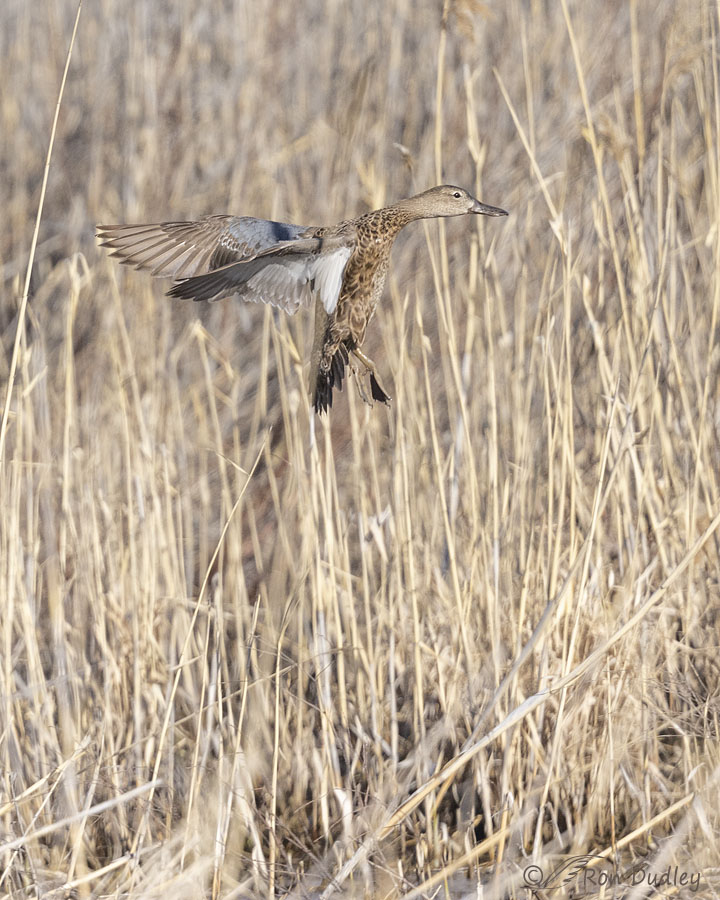
Ducks land at a pretty good clip and these teals are about to land right in the middle of all those vertical stems. Running into one or more of the phrag stems at speed would be a potential disaster so this posture is the result of her applying her air brakes so she can drop down at a steep angle into a relatively open area without hitting anything. And that’s exactly what they both did. Plop!
OK, that’s enough. I could include more photos from that morning but I don’t want to overdo it. Maybe I already have.
Ron


What a great comparison of the difference in the bills of Clark’s and Western Grebes! I can look at both of them together on my screen. I always thought the were more allke.
Great group of photos! So entertaining to see all the different species – I envy your very “bird” day!
Thank you, Joanne.
Love, love, love your birdpourri posts, Ron! This post is no exception and you have not overdone it with bird images. It’s a delight to see so many birds getting “in the mood” and glad that there are plenty of midges to munch on (although sorry that those same midges will be munching on you).
It’s a delight to see so many birds getting “in the mood” and glad that there are plenty of midges to munch on (although sorry that those same midges will be munching on you).
Thanks, Marty. Actually, midges don’t bite or sting. But the huge dense clouds of them can be incredibly intimidating to folks who don’t know that. The only problem I have with them is that when they’re thick you can’t shoot through them and get good photos. But I can live with that – I’m glad to have them around.
Mosquitoes and gnats – another story.
The blackbird photo is numero uno! Absolutely adore your potpourri posts Ron
Thank you, Kathleen.
Bear River is always the first place I ask to be taken whenever I’m visiting in Utah so love seeing your pictures. You can’t post too many of that wonderful place. And when I get home, always have the urge to re-read “Refuge,” Terry Tempest Williams.
Shirley, Bear River in the spring and early summer can’t be beat. “Refuge” is sitting in a place of honor in my living room bookshelves.
Thank you, Ron, for this lovely mix-up! My mother-in-law once saw Yellow-headed blackbirds and talked excitedly about them every time we saw her. Your photos of them show why she adored them so. Perfect, perfect, thank you!
I’m glad to hear that she liked them so much, Carolyn. Thanks.
Pot pourri often gives me an almost instant blinding headache teamed with nausea.
NOT yours.
Thank you – and not an image too much (she says greedily).
I don’t like the smelly kind either, EC. Not one bit.
Lots of great information, as well as photos, in this post Ron. Definitely not too much. I just saw my first pelicans in Fort Collins last weekend, and a couple of groups in flight this week, so it feels like Spring. I really like your shot with the snowy mountains in the background, as it captures the changing seasons for me. And thanks for the grebe identification hint – I’ll be looking for that when the one or two grebes (hopefully) show up in the pond near my house.
” I’ll be looking for that when the one or two grebes (hopefully) show up in the pond near my house.”
Bill, it’s an easy field mark to spot in the field and it’s reliable so I find it very useful.
A few years ago, I happened to take a shot of some Grebes in an estuary near Ft. Bragg, CA. I had never seen this bird before so had to do some ID research. Turns out two were Western Grebe’s and one was a Clark’s Grebe. I remember how to tell them apart by thinking of the black mask of The Lone Ranger (from my childhood TV-watching days). The Lone Ranger was a “Western” icon with his black mask over his eyes. Now when I see a Grebe with black surrounding it’s eyes, I know it is a “Western” Grebe … just like The Lone Ranger. Perhaps a bit convoluted, but it works for me.
Karen, I’ve used similar strategies to help me remember things for years. Because they work!
Very nice series and interesting that you and I were there roughly minutes apart in progression on the loop and found and took such different bird photos. Most of the ducks were not close for me and very flighty. Yet the cranes and snowy egret were in better location for me than you. I did take blackbird shots but have not processed them yet. I have a few of the grebes, pelicans and one swan. I was delighted with the snow goose fly overs. I spent most of my time with the avocets and stilts. Did you notice the Franklin’s gulls and a couple of terns out in the open marsh? I was hoping they would come in closer and sat some time watching. They seemed happy just resting and I moved on.
April, I never saw the Snow Geese. Yes, I saw, and photographed poorly, I think it was 3 Franklin’s Gulls. I also photographed a few of them along the AI causeway a few days before that.
It is yet another exceedingly gray day in SoCal, so your avian potpourri with plenty of sun and blue sky is most welcome! The sight of a Meadowlark—my dad’s favorite bird—always cheers me up. I swear I can hear his song in this image! And good news that the midges are back ….
Thanks, Chris. I hope your weather isn’t headed this way. It’s cold and gloomy here now but your weather coming this way would extend the misery.
Great variety this morning. I wish our cool, wet weather would finally begin to look like spring so I could get out more comfortably again.
As for the grebes, Clark’s and Western were considered just two color morphs of the same species for many years. The do look and behave very similarly and can be found in the same habitats. It turns out, however, that there is very little evidence to suggest the two species ever interbreed, even when found side-by-side in the same marsh. DNA evidence also shows them to be well separated.
Thanks for that background, Dan. We were 83° two days ago. It’s snowing right now.
Whatever criteria you use for standalone status escapes me. I think each one could be a post in itself. I agree with John Sherrill; a brochure it could be.
I’m glad you like them that much, Lyle. Sometimes I’m not a very good judge of what photos would appeal to my readers.
Really lovely series….thank you Ron!
Do the Pelicans stay there all winter? I thought they migrated.
Also I thought of you and wished you were present with your camera the other day when I took a hike and heard an unidentifiable bird sound, looked up, and there were two TUVUs *mating* on top of a flat-topped snag!!!!
My jaw dropped and I immediately wished you were there with your camera!!
It was amazing
They do migrate, Karina. They’re back.
Lucky you. As much time as I’ve spent with Turkey Vultures, I’ve never seen them mating.
wow, guess i didn’t realize Pelicans came back this early, but then it is April!
and with the Turkey Vultures, it felt like a gift of a lifetime and I so wish you could run across this and photo document it. Here’s hoping
What a treat it is to be able to share your species-abundant day ! Like Bruce,
I especially liked the 2 blackbird photo-glad you decided to include it-and was interested in the way to differentiate the 2 kinds of grebe. I join in Kim’s sentiments– FP is a wonderful way to start my day, every day !
Thanks very much, Kris.
Makes me want to go there! You’ve just produced Bear River MBR ‘s next brochure.
It’s worth a visit, John. Or two.
Thank you so much for all of your gorgeous pictures and informative texts. The first thing I do in the morning after I wake up is check your post, such a great way to start the day. Thank you.
“such a great way to start the day”
Very good to know. Thanks, Kim.
What a great post Ron! So many beautiful birds and interesting bits of information. Thanks!
Thanks very much, Mark.
That is definitely a great variety. I really like the Red-winged Blackbird with the Yellow-headed Blackbird in the background. The long grass stem on the right fading out of focus really supports the two birds.
Good to know you like that shot, Bruce. I almost didn’t include it for a couple of reasons but I’m beginning to learn that my instinct regarding what my viewers will like isn’t very reliable.
That is one of my favorite shots!
Fun series, Ron….. We often get one or two yellow-headed blackbirds in with Red-winged when they first show up tho they don’t usually stay. GBH’s are always a treat and love the Pelicans when they fly in sync in formation – appear to just be floating on the air.. Putting on the brakes to land in those phrags DOES make sense
We often get one or two yellow-headed blackbirds in with Red-winged when they first show up tho they don’t usually stay. GBH’s are always a treat and love the Pelicans when they fly in sync in formation – appear to just be floating on the air.. Putting on the brakes to land in those phrags DOES make sense 
Some decent rain last night and snowing this morning tho probably won’t amount to much – we’ll take it!
Judy, one of my favorite places to watch pelicans (and it has been for years) is in your neck of the woods – along the Missouri River and I-15 a little southwest of Great Falls.
The DO spend a fair amount of time on the river – only occasionally here. It’s always a bit of a startle to see them as they weren’t here when I was a kid – can’t tell you when they started coming either……
Another good place for pelicans up there is Lima Reservoir, just east of Lima.
Beautiful photos! Thank you! I saw a few turkeys from an unusual angle that I don’t remember seeing before, and noticed colors and posture more than I used to, and I attribute that to viewing your photos and descriptions. Funny how the fist thing i thought was “i wonder if Ron has seen them from this angle’, ha! They were descending in flight, about to land, and my view was of their backs below and angled towards me in my car. It was a pretty sight.
“I attribute that to viewing your photos and descriptions.”
Thanks for telling me that, JK. Good to know.
Enjoyed the Avian Potpourri this morning. It included a few of my favorites; American White Pelican, Western Meadowlark, and GBH.
I will concur with Kellie. Appreciate the Grebe comparison. I have little doubt that I have misidentified the Western in the past.
“I have little doubt that I have misidentified the Western in the past.”
I’ve occasionally done the same thing, Michael – even though I’m very familiar with the difference. There are many more Westerns than Clark’s so sometimes i just assume a grebe is a Western when it’s actually a Clark’s. When it comes to bird ID, one should never assume.
A very wonderful collection Ron!
Thank you, Rick.
I appreciate the Grebe tip! Great images and variety too!
“I appreciate the Grebe tip.”
Good. I’ve provided that tip at least once in the past but there are always new readers, or old readers that missed it, so I decided to include it again. Thanks, Kellie.